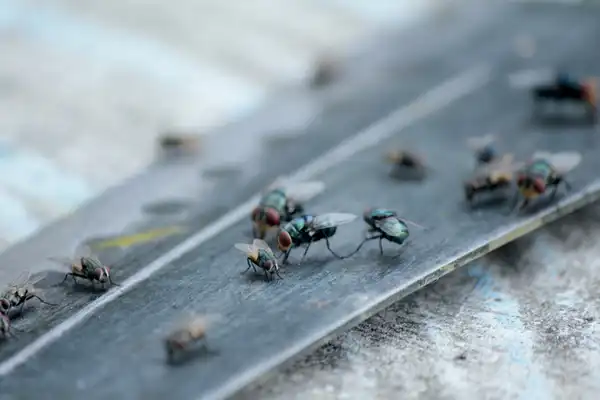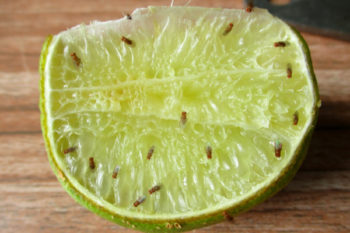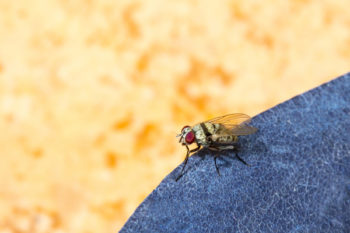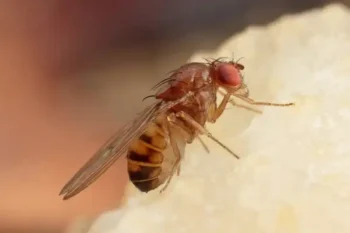
It’s getting to that time of year again. Just when it’s finally getting nice out again, they return: flies. Thousands of them. Hundreds of thousands. It seems like they’re everywhere around your home, and so suddenly! What are these flies? Where did they come from? Most importantly, what can you do about them? Don’t worry: Griffin Pest Solutions is here to answer all of your questions about where fly problems come from.
From spring to summer, and even in fall and winter, flies in your business can be a lingering nuisance. But they don’t have to be. Learn everything you need to know about indoor fly problems – and if you still have questions, give us a call!
What Types of Flies Do You Find in Businesses?
Several different fly varieties commonly enter business establishments. Each type of fly wants different things and behaves in different ways. Here is a brief rundown of the most common types of flies you’re likely to find in your Michigan business:
- House Flies are amongst the most common insect pests infesting properties in Michigan. House flies are ⅛ to ¼ inches long, dark grey, broad flies with dark stripes and dark red eyes. They live in garbage, particularly moist or rotting organic material.
- Fruit Flies and specifically the common fruit fly Drosophila melanogaster are very common infesters. Fruit flies are only 3 to 4 mm long, tan, or clear-colored flies with bright red eyes. Fruit flies live in fermenting liquids, especially sugary liquids.
- Blow Flies are particularly common in spring and summer. Blow flies are round, metallic green, blue, or copper-colored and only around ¼ to ½ inches long.
- Cluster Flies look similar to house flies and blow flies. Cluster flies are about 8 mm long, dark gray, and non-metallic. As their name suggests, they can often be found in large clusters.
Need an Estimate for Fly Extermination?
Why Do Flies Come Inside Businesses?
As you’ve probably noticed, each of those commonly found flies has a few things in common. The big one? Garbage. Virtually every fly loves living around, reproducing in, and feeding on garbage. More specifically, they love moist, rotting, or fermenting organic material. They’re attracted to any garbage that rots, breaks down, or starts to stink.
Flies can live off of and produce eggs in a very thin film of moisture. Even runoff from plumbing leaks or condensation from drafts is enough. If you have flies in your commercial property, it’s probably because they’ve found rotting material or humidity nearby. If you have flies, it means your property provides the three things they need most:
- Food: Flies have a highly attuned ability to sense rotting organic matter that they can use as a food source.
- Water: Like every living thing, flies need to drink water to survive. You would be surprised at how big of an effect drying up excess moisture can have on your fly control.
- Shelter: Flies are vulnerable to cold temperatures, so if it’s fall or winter, they’ll likely be looking for somewhere warm to stay. If they so happen to find it in your space, you can bet they won’t be leaving anytime soon.

Where Do Flies Come From?
The first generation has to get inside your business somehow. That can happen in several different ways. Cluster flies work their way inside starting in late summer and fall. They cluster together in large groups on the sides of walls to soak up the sun and stay warm. As temperatures cool, the flies look for cracks and gaps they can use to stay out of the wind. Often, these cracks may lead them into your business, either behind the walls or in attics and basements. Common access points include cracks under the baseboard, windows or door trim, and around fans, lights, or utilities.
Fruit flies may infiltrate your property by hiding inside grocery bags or other transported food materials. Fruit fly eggs are tiny and very difficult to see. If you accidentally bring a couple of eggs indoors, those eggs may hatch and grow into an infestation. Adult fruit flies can also sense rotting or fermenting material and follow it back to your business. They may lay their eggs around your garbage or other areas where they can find rotting food.
 Flies are very good at sensing temperature changes and rotting food. They’ll follow the smell of rotting food to drafts, then use small cracks to wiggle inside. Flies can often be found in large numbers in garbage or recycling centers, near schools, restaurants, shopping centers, or wetland areas.
Flies are very good at sensing temperature changes and rotting food. They’ll follow the smell of rotting food to drafts, then use small cracks to wiggle inside. Flies can often be found in large numbers in garbage or recycling centers, near schools, restaurants, shopping centers, or wetland areas.
The truth is, however, that most of the flies in your business were probably born there. It may start with a small number of flies that lay eggs in thin films of moisture near food sources. When the eggs hatch, offspring feed and grow rapidly until they’re fully grown. Then, the fully-grown adults reproduce, and before you know it you have a fly infestation.
What Time of Year are Flies Most Common?
The speed of a fly’s life cycle is determined mostly by temperature. During warm seasons, most fly species complete their life cycles extremely quickly. Houseflies, for instance, may complete their life cycle from egg to adult in seven to ten days. The longer and warmer the summer, the more the pests will grow, mate, and spread.
Files have incredible reproductive capabilities: a single fruit fly, for instance, could lay up to 500 eggs. They seem especially prevalent in spring and summer because warm outdoor temperatures allow them to reproduce even more frequently. It’s not just you; they are pretty much everywhere.
Fly Problems in the Winter
Flies are most common in the spring and summer – these seasons have conditions most conducive to reproduction – but that doesn’t mean you can’t still get a fly problem in the winter.
Where Do Flies Come From in Winter?
Having flies in your commercial establishment is never fun, but during the winter it’s downright intolerable. After everything else you have to put up with, you don’t even get a break from pests? Unfortunately, flies are surprisingly common indoor pests during the winter. They might be around even if you can’t see them!
Winter flies may seem inexplicable, but, as always, there’s a pretty straightforward reason they’re in your space. Learning why your flies are around and what they want will help you make sure they can’t get it. Here’s all the info you should know about flies in winter, including how to keep them out.
How Do Flies Survive Winter?
 “Filth” flies like blow flies, fruit flies, and phorid flies tend to live in and around garbage all year. During the winter, they simply nestle into garbage in sheltered areas and hunker down to preserve heat.
“Filth” flies like blow flies, fruit flies, and phorid flies tend to live in and around garbage all year. During the winter, they simply nestle into garbage in sheltered areas and hunker down to preserve heat.
Other flies, such as cluster flies, lay eggs in warm areas during the fall. The flies laying the eggs die of natural causes, but their offspring hatch all winter. Once the offspring are inside, they can continue reproducing, laying eggs, and hatching. Larger flies, like cluster flies, may also enter a hibernation-like state of diapause to preserve energy and body heat. When the weather warms in spring, they wake up and begin life anew.
How Do You Get Rid of Flies in the Winter?
If you can keep pests from accessing moisture, you can keep them from reproducing in your business. Flies usually find moisture around garbage or another source of food. Keep garbage cans sealed whenever you aren’t using them. Take out all your garbage every night before bed. Rinse out and dry containers before disposing of them.
Pay close attention to possible plumbing leaks and other sources of runoff. Check under sinks in the kitchen and bathroom, especially around garbage. Consider investing in dehumidifiers for particularly humid areas of your establishment. Clean up and prevent any other sources of excess moisture, too. No matter how small it may seem, flies can and will use it.
Once established, flies can be annoyingly difficult to eliminate. It’s quite hard to find fly eggs, and once they hatch you’ll have a new generation to deal with. It’s much easier to avoid letting pests reproduce in your commercial area in the first place. By following these tips, you can do just that. Of course, if a fly infestation has established a foothold, it can be quite difficult to contain — and we recommend consulting with your trusted fly exterminators.
Need Help? Call Michigan’s Commercial Fly Control Experts
The good news is that flies aren’t really a big deal. None of the common flies that get in your business can hurt you, your employees, or your inventory. At worst, you should consider them an annoyance. The bad news is, even if they’re “just” an annoyance, they’re still… very annoying.
Luckily, you don’t have to deal with your flies. When you decide enough is enough, just give Griffin Pest Solutions a call. We’ll wipe out your flies so you can get back to enjoying the season in peace.
Back to Fly Exterminators – Control – Removal